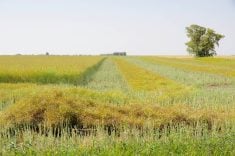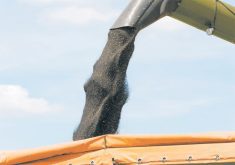Gene editing could help plant breeders find replacements as older genetic modification technologies develop resistance
Glacier FarmMedia – New genomic discovery methods will help farmers deal with older genetically modified crop traits that are no longer working as well as they used to.
For example, corn rootworm is developing resistance to the Bt traits that have for years controlled the significant corn pest in North America.
New genomic tools like genome sequencing and the ability to stack genes through CRISPR gene editing mean that there will be solutions.
Read Also

Canadian Food Inspection Agency extends chronic wasting disease control program consultation deadline
Date extended for consultation period of changes to CWD program
Tim Kelliher, head of crop, trait and technology discovery for field crops at Syngenta Seeds, told a visiting group of journalists during a media tour at Syngenta’s Research and Development Innovation Centre near Malta, Illinois, that genome sequencing and gene editing will bring new traits to market quicker.
In the case of corn rootworm control, Kelliher says he expects new solutions to evolve over the next number of years.
“There are definitely things that are coming,” he says.
In the past, bacteria colonies had to be screened for insect management traits. Now, with whole genome sequencing, it’s easier to identify which bacteria could provide the next big insect control.
“We can batch all those colonies together, run them through a genome sequence analyzer and based on sequencing those genes, predict which of those genes we think would actually kill the bug because we know what these proteins tend to look like,” says Kelliher.
The rapid evolution of artificial intelligence could mean that in a few years, a researcher could ask a computer to design a specific protein that they know will help manage a crop pest.
Gene editing involves snipping genes precisely, turning genes on and off and adding in traits.
There are many uses for the ability to edit the existing genes within plants including improving yield, disease and drought resistance, but insect resistant traits will continue to need the introduction of traits from outside of the plant genome, says Kelliher.
Gene editing makes the introduction of those traits more precise than previous genetic modification techniques.
That precision means more predictable trait stacks, so multiple insect control traits can exist within one corn plant for better control over resistant insects or plants.
When gene-edited plants are crossed with others, the stacked traits are all together in one area of a chromosome and that simplifies the breeding process.
Corn and soybeans are the focus of much of the work at the Malta research station, but the less expensive nature of gene editing could mean the technology will also be used in crops like wheat, canola and lentils.
Kelliher also expects that gene editing will help create resistance to diseases, such as soybean rust in South America and the United States, which is a growing concern.
Once a soybean rust resistant line is found —and it could be from an ancient relative of soybeans — and the gene sequence that delivers tolerance is found, a couple of changes to the genome may be all that’s needed, says Kelliher, who works at the Syngenta Seeds Research and Development Centre of Excellence in Research Triangle Park, near Raleigh-Durham in North Carolina, where 500 people work on advanced seed research.
The small changes to the genome can be achieved using what’s called guide RNA and the CRISPR enzyme.
“Then suddenly we have a commercial line that is ready to go that now has their natural resistance built into its genetic code,” he says.
The quicker process can save millions of dollars and years of crop development time — and it will mean solutions that arrive faster into the hands of farmers.
















